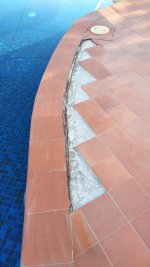I'm undertaking a task of replacing some cracked and loose terracotta tiles around our pool. The issue has been caused by the surrounding paving sinking over many years. The pool is around 30 years old so I am not overly concerned this is a serious issue, just age related, and I just want to repair this area to make it safe, no sharp edges, and to protect from water ingress under the pavers.
Yes I know this is a band-aid fix, yes it won't look great, but we don't have the budget to replace the paving to the whole area so this will hopefully get a few years or more until we can afford it and I have some spare matching tiles.
My question is around bedding in the new tiles, now that I have lifted the old tiles and prepared the area you can see a gap in the concrete between the coping and the surrounding tiles. I believe this would be two different pours, and there may need to be some movement here? There is silicone installed between the coping tiles and the rest. Should I bed the tiles over the crack all the way to the coping tiles or should I only bed them up to the crack, and not glue them further? This could create its own problem having a hollow area under part of the tile. Am I overthinking this?
Yes I know this is a band-aid fix, yes it won't look great, but we don't have the budget to replace the paving to the whole area so this will hopefully get a few years or more until we can afford it and I have some spare matching tiles.
My question is around bedding in the new tiles, now that I have lifted the old tiles and prepared the area you can see a gap in the concrete between the coping and the surrounding tiles. I believe this would be two different pours, and there may need to be some movement here? There is silicone installed between the coping tiles and the rest. Should I bed the tiles over the crack all the way to the coping tiles or should I only bed them up to the crack, and not glue them further? This could create its own problem having a hollow area under part of the tile. Am I overthinking this?


